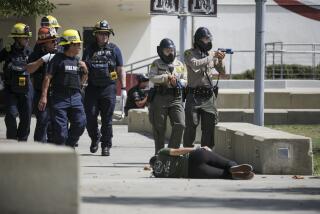Man Angered by Changes in Bill Inspired by Son’s Death
SACRAMENTO — Thomas Lanni is nothing short of bewildered after his first brush with the business of making laws in California.
After his 7-year-old son was hit and killed by a pickup truck while getting off a school bus in Laguna Niguel in April, Lanni decided to try to salvage something positive from the family tragedy. He began pushing for a state law making it mandatory for bus drivers to flash warning lights to get traffic to stop whenever children are disembarking.
Lanni, an electrical engineer, figured it was a legislative slam-dunk. But not in Sacramento. Despite the best efforts of Sen. Marian Bergeson (R-Newport Beach), the bill was watered down in committee because of fears that flashing lights could cause traffic accidents and congestion.
The measure, expected to win approval this week, gives school districts wide discretion to select the bus stops where drivers should flash the lights.
To Lanni, that’s simply not good enough. “They’ve emasculated the bill,” he said. “In its present form, this bill is tantamount to no change at all. I don’t know what the underlying motivations are, but it’s apparent the people in Sacramento are out of touch with reality.”
With the bill eventually expected to reach the desk of Gov. Pete Wilson, who has not taken a stance on the issue, Lanni said he might write a letter asking the governor to veto it. “My fear is passage of this bill will lead people to believe something has been done, when in reality nothing has been done,” Lanni said.
Bergeson said she understands Lanni’s frustrations with the ways and wiles of the Capitol but emphasized that her measure is a good first step and makes changes that help.
“We pushed as hard as we could,” Bergeson said. “I think we came out with the best we could. It will be a benefit, and lives will be saved.”
Existing law requires school bus drivers to flash the warning lights only when students are going to cross the street. Bergeson’s bill would allow districts to designate the use of the lights at certain dangerous stops, even if students are not crossing the street. A district would have to get permission from the California Highway Patrol and the local traffic engineering department to give the stop that designation.
The bill was extensively altered during a Senate Transportation Committee hearing by legislators who feared that requiring school buses to use their warning lights at every stop would do more harm than good.
M. Mehdi Morshed, a committee consultant, said the change would have had “serious ramifications,” giving children a false sense of security, causing traffic congestion and increasing the likelihood of accidents. The problems would be particularly increased at bus stops along busy, multilane thoroughfares where traffic speeds often approach 50 m.p.h., Morshed said.
“On the surface it looks like a wonderful idea,” Morshed said. “But when you apply it to major arterials, it just simply doesn’t work.”
Lanni doesn’t accept such reasoning. “They talk about driver inconvenience,” he said. “I suggest someone talk to the fellow who hit my son and ask him how much of an inconvenience it would have been to stop. I think he’d say he would have been glad to stop.”
More to Read
Get the L.A. Times Politics newsletter
Deeply reported insights into legislation, politics and policy from Sacramento, Washington and beyond. In your inbox three times per week.
You may occasionally receive promotional content from the Los Angeles Times.










